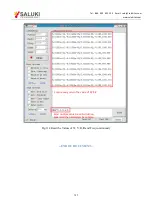
Tel: 886. 909 602 109 Email: [email protected]
www.salukitec.com
117
7.3 Optical Spectral Measurements
This example will show how to measure a spectral diagram of any light source. You need an optical chopper (such
as SIGNAL RECOVERY MODEL 197 Light Chopper), a grating monochromator (such as WDG15-Z) and its
control system, a photoelectric detector (such as the S286 series photodiode of Japan Hamamatsu Company), a data
collection platform (such as NI cDAQ-9172) and a PC. You should control the monochromator to sweep
automatically in the spectral measurement range. Then measure the photo current by the SE1022. The steps are as
follows:
1. Disconnect all cables from the lock-in. Connect the power source and then turn on the power switch. The system
is in default.
2. Set the corresponding parameters of SE1022.
(1) Press [INPUT/FILTERS] and then set the input mode to <I> and <Amplitude: 1M>. Other settings remain the
default.
(2) Press [REF/PHASE] and then set <Ref. Source: External> and <Type: TTL>.
(3) Press [GAIN/TC] and then set <Sensitivity: 1μA> which can be adjusted in measurement,
<Reserve: Normal>, <TC: 300ms> and <Roll off: 12dB/oct>. Finally, turn off the SYNC filter.
(4) Press [OUTPUT/OFFSET] and then set <CH1>, <Source: R> and <Speed: Fast>.
3. Build up the spectral measurement platform.
Use a BNC cable to connect the output of the photoelectric detector and the A/I input of the SE1022.
Use a BNC cable to connect the Sync out f1 of the optical chopper and the REF IN of the SE1022.
Use a BNC cable to connect the data collection platform and the CH1 OUT of the SE1022. The sketch is shown in
Fig.102.
The actual connect figure is shown in Fig.103.

























